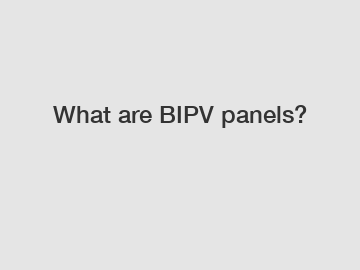What are BIPV panels?
What are BIPV panels? BIPV stands for Building Integrated Photovoltaic panels. These panels are a type of solar technology that are seamlessly integrated into the architecture of buildings. Unlike traditional solar panels that are added onto existing structures, BIPV panels are designed to blend in with the building's design, serving both a functional and aesthetic purpose.
The concept of BIPV panels can be traced back to the 1970s when researchers and architects started exploring the idea of incorporating solar cells into building materials. The initial goal was to promote sustainability and reduce dependence on fossil fuels. Over the years, advancements in technology and design have made BIPV panels more efficient and cost-effective, leading to their growing popularity in the construction industry.
The implementation of BIPV panels offers several benefits. Firstly, it allows for the generation of clean and renewable energy directly from the building itself. This means that buildings can become self-sufficient in terms of energy production, reducing reliance on traditional power grids and decreasing greenhouse gas emissions.

Additionally, BIPV panels can contribute to the overall energy efficiency of a building. By harnessing solar energy, they can power various electrical systems, such as lighting and heating, resulting in cost savings and reduced energy consumption. Moreover, these panels can also act as insulation, regulating the temperature inside the building and reducing the need for artificial cooling or heating.
From an architectural standpoint, BIPV panels offer endless design possibilities. They can be seamlessly integrated into various building elements, such as windows, façades, and roofs, without compromising the overall aesthetics. This integration enhances the visual appeal of buildings while simultaneously harnessing solar energy. Furthermore, BIPV panels can be customized to fit different shapes, sizes, and colors, allowing architects to create unique and sustainable designs.
The widespread adoption of BIPV panels also has significant environmental impacts. By encouraging the use of renewable energy, these panels contribute to the reduction of carbon emissions, mitigating the effects of climate change. They also promote sustainable development practices and set an example for future building projects.
In conclusion, BIPV panels are an innovative solar technology that seamlessly integrates photovoltaic systems into the architecture of buildings. Their development has been driven by a desire for sustainability and energy efficiency. The integration of BIPV panels offers numerous benefits, including clean energy generation, cost savings, improved aesthetics, and reduced environmental impact. As the construction industry continues to prioritize sustainability, BIPV panels are likely to become increasingly prevalent in building designs worldwide.
Are you interested in learning more about bipv solar roof tiles, China solar tile company, bipv curtain walls? Contact us today to secure an expert consultation!
210
0
0

Comments
All Comments (0)